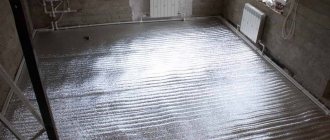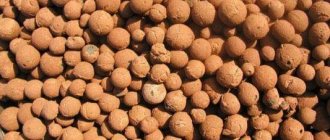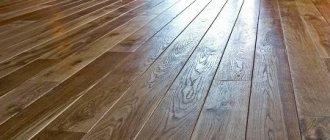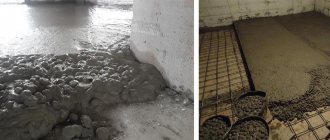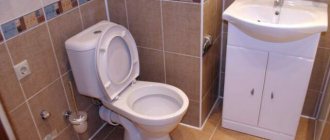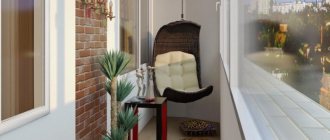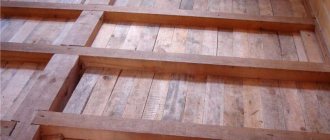Nowadays, the cost of heating housing and premises in general is constantly increasing. At the same time, for some reason, salaries remain almost the same - not a good trend, but it has to be taken into account. In such conditions, almost every owner of a house or apartment begins to worry about the issue of saving energy. Today, walls, floors, ceilings, and slopes are being insulated en masse - such measures make it possible to distribute heat throughout the room as efficiently as possible due to the fact that the level of heat transfer of the building is reduced.
This article will touch upon such a difficult issue as floor insulation - we will figure out what is better suited for this: mineral wool or expanded clay. In principle, foam plastic is also often used, but this is not the best option, because the possibility of ventilation and ventilation of the ceiling practically disappears. Although, undoubtedly, the thermal insulation characteristics of polystyrene foam are excellent.
So, mineral wool and expanded clay, which is better - you can start with a review of the first material and compare everything based on specific properties.
Expanded clay as floor insulation or mineral wool - the choice of specialists
Nowadays, the cost of heating housing and premises in general is constantly increasing.
At the same time, for some reason, salaries remain almost the same - not a good trend, but it has to be taken into account. In such conditions, almost every owner of a house or apartment begins to worry about the issue of saving energy. Today, walls, floors, ceilings, and slopes are being insulated en masse - such measures make it possible to distribute heat throughout the room as efficiently as possible due to the fact that the level of heat transfer of the building is reduced. This article will touch upon such a difficult issue as floor insulation - we will figure out what is better suited for this: mineral wool or expanded clay. In principle, foam plastic is also often used, but this is not the best option, because the possibility of ventilation and ventilation of the ceiling practically disappears. Although, undoubtedly, the thermal insulation characteristics of polystyrene foam are excellent.
So, mineral wool and expanded clay, which is better - you can start with a review of the first material and compare everything based on specific properties.
Why insulate?
If the balcony is closed, then it is better to insulate it. Otherwise, when the temperature fluctuates, condensation of excess moisture will occur on the walls and glass. Excessive dampness can lead to mold or mildew that is not easy to remove. Furniture and household items placed on the balcony will also deteriorate from increased dampness. An insulated balcony will become a cozy place to relax and safely store household items. Raising the floor using a layer of expanded clay and cement screed is a reliable way to increase the living area and create a thermal buffer that improves the microclimate in the room.
Expanded clay: natural and environmentally friendly
This free-flowing, porous and fairly lightweight building material differs from its analogues in that its basis is made up of special clay rocks containing quartz. Based on the dimensions and geometry of the granules, expanded clay is divided into:
- gravel (its granules have an elongated shape);
- crushed stone (with particles in the form of acute-angled cubes);
- sand (with granules whose size does not exceed five millimeters).
The quality of expanded clay is determined by volumetric weight, bulk density, porosity and strength. It is believed that a larger number of pores provides better heat-saving function of the insulation.
Describing the operational advantages of expanded clay, we should highlight:
- high thermal insulation ability (even a small layer of expanded clay under the floor can raise the level of thermal insulation to a new qualitative level);
- light weight (due to this parameter, expanded clay insulation can be used at all stages of construction);
- enviable soundproofness (this parameter is extremely important for residential construction);
- resistance to rotting, damage by rodents, fungus and mold);
- strength and durability (expanded clay is chemically inert, resistant to mechanical and temperature damage);
- flowability (that is, the ability to fill spaces of any shape and volume with such insulation);
- environmental safety (this is an environmentally friendly material without toxic impurities);
- water resistance (even if moisture gets into the expanded clay layer, its granules, due to the ventilated gaps, will act no worse than high-quality drainage);
- affordable price.
This inexpensive bulk insulation can be used to improve the quality of walls and floors, pitched roofs and basements. Thermal insulation of expanded clay floors (and any other elements) of a residential building requires strict adherence to technology.
2. We place beacons around the perimeter of the room.
3. Pour a layer of expanded clay (at least 150 mm thick) onto the sand layer.
4. Level the surface using fishing line.
5. Cover the expanded clay insulation with a waterproofing film.
6. Carefully pour the concrete solution.
7. Regularly moisten the surface with water for three to four weeks to prevent cracks from appearing.
Video: What is expanded clay? Its pros and cons
Mineral wool: practical and affordable
This soft material of large fibers is a product of metal waste and carbon mineral alloys. Due to its durability, fire resistance and ability to quickly install, mineral wool (in slabs, rolls and mats of various sizes) has become incredibly popular in the construction industry. It is especially valued for its breathability, which makes it an ideal insulation material for a wooden house.
Performance advantages of mineral wool:
- fire resistance;
- high sound insulation ability;
- non-susceptibility to deformation due to temperature changes;
- acceptable price.
Disadvantages of mineral wool that can be compensated for by proper handling of insulation and compliance with all installation technologies:
- fragility;
- insufficient resistance to moisture;
- insufficient environmental friendliness.
Mineral wool
– material with a loose structure. It does not retain steam, so its inner side must be vapor-insulated with a layer of foiled polyethylene. It is important to carefully seal seams formed at the border of insulation fragments using ordinary metallized adhesive tape.
When insulating the floor with mineral wool, keep in mind that its height will rise by about 50 mm. And remember: you will achieve a high-quality result only if you follow the insulation procedure. As an example, we offer a floor insulation system using joists.
1. Compact the soil.
2. Lay a layer of crushed stone, using bitumen mastic to waterproof it.
3. We install brick columns (longitudinal interval - 2 m, transverse - 60 m), waterproof them
4. Lay wooden logs.
5. At the bottom of each joist we fix a windproof layer (first a metal mesh, then a windproof film).
6. Place mineral wool on the film between the joists.
7. We protect the insulation with a vapor barrier layer.
8. We seal the joints between the sheets.
9. Lay the plank floor.
Video: What is mineral wool? Its pros and cons
Expanded clay or mineral wool?
Both materials are relatively inexpensive, boast a fairly simple installation process and decent insulation quality, so you should choose between expanded clay and mineral wool based on specific construction conditions, technical and financial capabilities. A good solution is a combination of these materials, as they complement each other well.
Choosing floor insulation: mineral wool, expanded clay, expanded polystyrene? Facade finishing: lining, block house, planken or siding?
Peculiarities
Each type of heat-insulating material has its own characteristics and physical characteristics. However, when choosing, experts recommend focusing on the following:
- Type room. It can be residential or non-residential.
- Strength. Since the insulation is laid on the floor, it will experience certain loads.
- Lifetime. Floors are rarely re-laid, which means that the material must retain its insulating properties for a long time.
- Thermal insulation level;
- Weight and density;
- Degree of moisture absorption;
- Vapor barrier;
- Fire safety;
- Environmental friendliness;
- Material consumption when cutting (waste should be as little as possible);
- Easy to handle and install.
Professionals note that the heat-insulating material under the concrete screed must have the following qualities:
- High density, which determines rigidity. The latter is necessary in order to withstand the weight of the screed.
- Moisture resistance, since the concrete solution contains water.
- Lack of open cells and pores in slabs and rolls. Particles of screed become clogged in them.
- Low degree of heat transfer, which will allow the use of thinner insulation.
The main requirement for thermal protection for a wooden floor is vapor permeability.
The heat exchange throughout the room depends on the floors. Depending on the type of residential structure, installation features vary.
Floor insulation in an apartment of a frame house on screw piles has its own characteristics. Buildings on pile foundations are erected on moist soil. With such a design, the house, as a rule, has a ventilated basement or basement.
Experts advise insulating the floor in layers:
- A frame skeleton that also serves as a subfloor. Its installation begins with fastening wooden beams to the joists; they will support the rough flooring boards.
- Wind protection, which performs the function of protecting the insulation from weathering. For this purpose, special insulating membranes are used. Since they are characterized by high cost, they can be replaced with polyethylene, which should be laid on top of the insulation.
- A heat insulator, on which, if necessary, an additional waterproof layer is laid.
- A finished floor consisting of chipboard, plywood or other material.
As heat-insulating materials, it is better to pay attention to insulation materials with high resistance to moisture. For example, polystyrene foam is good both in terms of cost and performance properties, but it is destroyed in frost and high humidity. This means that in this case it is necessary to protect it from external influences.
Another option for heat insulation is mineral wool, produced in the form of rolls or slabs. It is very profitable because it is inexpensive, has fairly high thermal protection and is resistant to fire. However, experts note that when water gets inside, all insulating properties are reduced to zero. The most suitable option for a building on screw piles is wool in the form of blocks, which has a more dense structure.
Penoplex is also used for frame houses, but it is more expensive compared to polystyrene foam and mineral wool. You should pay attention to its advantages: reliability, durability and almost zero water absorption.
You can often see expanded clay as insulation, but it is inferior to the above materials in terms of heat-protective functions.
When arranging a living space, professionals insist on protecting the pile foundation with a permanent base, as it will provide additional protection from wind and snow. If this is not necessary, then it is enough to install a decorative option.
In addition to the existing standard technology, there are others:
- Double thermal insulation. The technology involves laying double flooring.
- Cross thermal insulation. The method involves a perpendicular arrangement of insulating layers.
When insulating a frame house on stilts, it is very important to follow all the technology, otherwise you may end up with poor-quality insulation with a damp underground, mold and mildew.
In a brick apartment building, residents of the first floors often complain about the icy floor. Experts recommend that before installing thermal protection, you need to clarify what type of coating is available.
Brick houses, as a rule, have either wooden or concrete floors. If there is a concrete surface, the insulation process must necessarily include waterproofing to prevent the appearance of mold.
Work begins with preparing the base: eliminating cracks and cracks using cement mortar. Then the floor is impregnated with a strengthening compound. Next, a layer of waterproofing is laid, which in its simplest form can be a polyethylene film. A primer with deep penetration properties should also cope with its role. Afterwards, roofing material is spread, a frame of longitudinal beams and transverse joists is installed, into which heat-insulating material is poured or poured. Mineral wool or polystyrene foam can be placed on top of the insulating layer inside the frame. The last thing to attach is a vapor barrier film, on top of which the subfloor is mounted.
The entire structure takes a certain distance between the floor and the ceiling, which should be taken into account during repairs.
You can use a less expensive option without an insulating bulk “cushion”. It is enough to use one of the polymer insulation materials laid on concrete, but waterproofing is required in any case.
If you have a wooden floor, it is first recommended to replace the old floors and eliminate cracks, treat all elements with antiseptics and dry thoroughly. Then install roll or block insulation and cover it with a vapor barrier. The final stage is installation of the finished floor.
An apartment on the ground floor can be insulated not only from the residential side, but also from the basement. For this purpose, the basement ceiling is sheathed with a heat insulator, which can be polystyrene foam or polystyrene foam. They are easy to install because they simply stick to the ceiling. It would be appropriate to use mineral wool, but its installation requires some effort.
To insulate concrete floors, it is better to choose high-density protective agents: expanded clay, mineral wool mats, expanded polystyrene. Eco- or mineral wool, as well as rolled materials, are appropriate as insulation for wooden bases.
The features of floor insulation in a Khrushchev building differ from previous options. The main design feature of Khrushchev buildings are reinforced concrete slabs on the floor. To insulate them, a screed is used, but you need to remember that its layer should not be thick, since the floors are not designed for this. As a rule, to obtain a warm floor, it is enough to line the surface with polystyrene foam and fill it with a thin screed. Experts do not prohibit the use of self-leveling floors.
Reviews about mineral wool
Dmitry, 39 years old, Moscow: “I insulated the roof of the bathhouse with mineral wool. One winter has already passed, it is warm and dry. I checked through the inspection hatch - the insulation inside is dry, and there are no negative changes near the pipe either.”
Evgeniy, 44 years old, Volsk: “I insulated the inside of the loggia with mineral wool - the walls were under wooden lining and the floor was under OSB. I installed an electric radiator, and it turned out to be a small but cozy office.”
Table of thermal conductivity of materials on B
| Material | Density, kg/m3 | Thermal conductivity, W/(m deg) | Heat capacity, J/(kg deg) |
| Light mineral wool | 50 | 0.045 | 920 |
| Heavy mineral wool | 100…150 | 0.055 | 920 |
| Glass wool | 155…200 | 0.03 | 800 |
| Cotton wool | 30…100 | 0.042…0.049 | — |
| Cotton wool | 50…80 | 0.042 | 1700 |
| Slag wool | 200 | 0.05 | 750 |
| Vermiculite (in the form of bulk granules) GOST 12865-67 | 100…200 | 0.064…0.076 | 840 |
| Expanded vermiculite (GOST 12865-67) - backfill | 100…200 | 0.064…0.074 | 840 |
| Vermiculite concrete | 300…800 | 0.08…0.21 | 840 |
| Woolen felt | 150…330 | 0.045…0.052 | 1700 |
Expanded clay is an advantageous insulation material
Expanded clay is a building material used for insulating floor coverings and for leveling uneven surfaces . Craftsmen produce porous tools by firing clay slate. Within half an hour, expanded clay at temperatures up to 1300 C o 2 takes on an oval shape.
Externally, the insulation is a bit like crushed stone and gravel. Experts present several types of expanded clay. Here are some of them:
- Expanded clay sand . Used to reduce the weight of concrete structures. A distinctive feature of construction raw materials is small sand granules.
- Gravel . The following type of expanded clay is used in several cases: to create lightweight concrete products and as drainage for flowerpots. The material exhibits rather large granules (up to 44 mm).
- Expanded clay crushed stone . An excellent and high-quality product is used as a filler for lightweight concrete. The presented raw materials are obtained by crushing expanded clay gravel.
Determining the type of building material is easy. Just look at the size of the expanded clay granules. We should not forget about the positive qualities of this insulation. The advantages of expanded clay are:
- Long service life . Flooring created from a clay product can outlast a typical nine-story building.
- High level of thermal conductivity . Expanded clay retains heat longer and better than other building resources. 10 times better than brick and 3 times better than wood.
- Low cost and light weight . Low weight allows you to insulate floors with expanded clay in small rooms without additional structures and special reinforcing frames.
- High strength . The presence of such quality expands the scope of application of clay raw materials. Expanded clay is used not only to insulate flooring, but also walls and even ceilings. Constant loads do not detract from its strength.
- Excellent sound insulation . This is a definite plus when insulating personal apartments in multi-storey buildings.
- Easy installation . Laying insulation does not require lengthy and multi-step preparatory work. It is enough to remove the old coating.
- Excellent resistance to severe frosts and heat, that is, resistant to temperature fluctuations. Resists fire well.
Low moisture resistance is the main and only disadvantage of expanded clay. In the construction world, other types of insulation are widely used. For example, mineral wool.
Features of mineral wool
Mineral wool is a thermal insulation material made from fibers of mineral origin. The natural product is obtained by atomizing basalt, stones or certain slag. The raw materials used to make the material divide mineral wool into certain types. In practice, experts use slag wool, glass wool and basalt product.
Glass wool . To create such insulation, sand, dolomite, broken glass, borax, soda and limestone are used. Yellow insulation has good compressibility and low thermal conductivity. Cylinders, slabs or mats are made from glass wool. Such products improve the thermal insulation qualities of a living space.
Slag . The material created from blast furnace slag is famous for its high level of hygroscopicity, therefore it is not often used as insulation. An increased degree of acidity and low vibration resistance are the main disadvantages of such mineral wool.
Basalta . The soft product is known for its non-flammability and vibration resistance. The strength and elasticity of insulation depends on its density. Basalt wool is often used for fire insulation in air ducts.
The main advantages of mineral wool should be mentioned. These include:
- High level of chemical and biological resistance . The mineral product is not affected by rodents, rats and other pests. Good moisture resistance protects mineral wool from fungus and mold.
- Fire safety . Resistance to high temperatures allows the use of mineral wool for insulation of floors and interfloor ceilings. Mineral wool does not spread fire in the event of a fire, but on the contrary helps to extinguish it.
- The environmentally friendly material is known for its long service life . Atmospheric fluctuations and room humidity do not shorten the service life of the product.
- Copes well with static loads.
The disadvantages of mineral wool include the need to use protective gloves when working with raw materials, as well as the need to stock up on other materials when insulating surfaces with such a tool.
Choosing insulation for the floor
Warm floor – warm home. This statement does not require proof. But you can insulate the floor for mere pennies, and by investing a lot of money and effort into a complex electric or water heating system.
Which insulation is best for the floor is decided by everyone for themselves, based on the design features of the room and the expected budget.
Expanded clay
Expanded clay is one of the cheapest and most accessible insulation materials..
Its advantages are obvious:
- Excellent thermal insulation and sound absorption characteristics;
- Fire resistance and resistance to temperature changes;
- Light weight – expanded clay only slightly weighs down the structure;
- Fired expanded clay granules do not harbor rodents.
Note! In order for expanded clay to retain heat, its layer must be 10-15 cm thick. This is perhaps the only serious disadvantage of insulation - raising the floor level and reducing the ceiling height (especially important for standard apartments).
Expanded clay has long been successfully used for floor insulation, pouring it under gypsum plasterboard sheets, pouring concrete or cement mortar onto it, constructing a floating screed.
Which is cheaper: comparison of the cost of two materials
1 cubic meter of expanded clay gravel can be bought for 1,500 rubles, 1 roll of mineral wool measuring 8200x1220x50 mm costs from 1,400 rubles.
The cost estimate for insulation should include costs for:
- for the services of loaders - for the delivery of heavy bags of expanded clay;
- additional consumables - timber, vapor barrier membrane, fasteners;
- personal protective equipment – important when using mineral wool insulation.
To simultaneously solve the problems of thermal insulation and sound insulation, it is clear that mineral wool is better. Expanded clay is not an insulation material, and the low cost of the material can be completely offset by the need to use it in large quantities.
How to replace expanded clay concrete, are there any analogues?
If it seems to you that expanded clay concrete is too heavy for your purposes, and specifically for bulk thermal insulation, you can turn to other porous and expanded backfills. In particular, it is similar to expanded clay concrete, similar in its characteristics to agloporite, a kind of pumice with a composition identical to glass. This filler is made from brick clays mixed with a mixture of coal and shale mining waste, as well as with ash and slag from the combustion chambers of thermal power plants. However, the environmental friendliness of this material is questionable. Another replacement for expanded clay concrete is expanded perlite sand, its moisture absorption is even lower than that of expanded clay concrete, only 3-5%, but its thermal conductivity is only 0.04, like basalt wool.
The best option than replacing expanded clay concrete is expanded vermiculite. This is an environmentally friendly material, produced from rocks belonging to the hydromica group (remember the mica plates that were inserted into windows in Kievan Rus). To compare, the thermal conductivity index of expanded clay concrete is 0.1, and that of vermiculite is 0.08, which is several times less than that of mineral-based wool. The volumetric weight of a cubic meter of expanded vermiculite is 100 kilograms, which is small. The use of this material will ultimately result in a thinner layer of backfill, less load on the floor and will be a completely suitable base for the screed.
Table of thermal conductivity of materials on A
| Material | Density, kg/m3 | Thermal conductivity, W/(m deg) | Heat capacity, J/(kg deg) |
| ABS (ABS plastic) | 1030…1060 | 0.13…0.22 | 1300…2300 |
| Aggloporite concrete and concrete based on fuel (boiler) slags | 1000…1800 | 0.29…0.7 | 840 |
| Acrylic (acrylic glass, polymethyl methacrylate, plexiglass) GOST 17622-72 | 1100…1200 | 0.21 | — |
| Alfol | 20…40 | 0.118…0.135 | — |
| Aluminum (GOST 22233-83) | 2600 | 221 | 840 |
| Fibrous asbestos | 470 | 0.16 | 1050 |
| Asbestos cement | 1500…1900 | 1.76 | 1500 |
| Asbestos cement sheet | 1600 | 0.4 | 1500 |
| Asbozurite | 400…650 | 0.14…0.19 | — |
| Asbomica | 450…620 | 0.13…0.15 | — |
| Asbotekstolit G (GOST 5-78) | 1500…1700 | — | 1670 |
| Asbothermite | 500 | 0.116…0.14 | — |
| Asbestos slate with high asbestos content | 1800 | 0.17…0.35 | — |
| Asboshifer with 10-50% asbestos | 1800 | 0.64…0.52 | — |
| Felt asbestos cement | 144 | 0.078 | — |
| Asphalt | 1100…2110 | 0.7 | 1700…2100 |
| Asphalt concrete (GOST 9128-84) | 2100 | 1.05 | 1680 |
| Asphalt in floors | — | 0.8 | — |
| Acetal (polyacetal, polyformaldehyde) POM | 1400 | 0.22 | — |
| Airgel (Aspen aerogels) | 110…200 | 0.014…0.021 | 700 |
Expanded clay: natural and environmentally friendly
This free-flowing, porous and fairly lightweight building material differs from its analogues in that its basis is made up of special clay rocks containing quartz. Based on the dimensions and geometry of the granules, expanded clay is divided into:
- gravel (its granules have an elongated shape);
- crushed stone (with particles in the form of acute-angled cubes);
- sand (with granules whose size does not exceed five millimeters).
The quality of expanded clay is determined by volumetric weight, bulk density, porosity and strength. It is believed that a larger number of pores provides better heat-saving function of the insulation.
Describing the operational advantages of expanded clay, we should highlight:
- high thermal insulation ability (even a small layer of expanded clay under the floor can raise the level of thermal insulation to a new qualitative level);
- light weight (due to this parameter, expanded clay insulation can be used at all stages of construction);
- enviable soundproofness (this parameter is extremely important for residential construction);
- resistance to rotting, damage by rodents, fungus and mold);
- strength and durability (expanded clay is chemically inert, resistant to mechanical and temperature damage);
- flowability (that is, the ability to fill spaces of any shape and volume with such insulation);
- environmental safety (this is an environmentally friendly material without toxic impurities);
- water resistance (even if moisture gets into the expanded clay layer, its granules, due to the ventilated gaps, will act no worse than high-quality drainage);
- affordable price.
This inexpensive bulk insulation can be used to improve the quality of walls and floors, pitched roofs and basements. Thermal insulation of expanded clay floors (and any other elements) of a residential building requires strict adherence to technology.
2. We place beacons around the perimeter of the room.
3. Pour a layer of expanded clay (at least 150 mm thick) onto the sand layer.
4. Level the surface using fishing line.
5. Cover the expanded clay insulation with a waterproofing film.
6. Carefully pour the concrete solution.
7. Regularly moisten the surface with water for three to four weeks to prevent cracks from appearing.
Video: What is expanded clay? Its pros and cons
Mineral wool: practical and affordable
This soft material of large fibers is a product of metal waste and carbon mineral alloys. Due to its durability, fire resistance and ability to quickly install, mineral wool (in slabs, rolls and mats of various sizes) has become incredibly popular in the construction industry. It is especially valued for its breathability, which makes it an ideal insulation material for a wooden house.
Advice from professionals
When insulating a balcony with expanded clay, you must use a protective mask or respirator to protect your respiratory tract from dust. The most dense layer of material is obtained from a mixture of all three fractions, but you need to keep in mind that a large amount of sand will increase the weight of the insulation and, consequently, the load on the balcony floor. Ordinary polyethylene film can be used as a waterproofing material.
There are standards for constructing large area screeds. You cannot fill large areas of the floor at once. If the floor on the balcony has an area of more than 25 square meters. m, you should divide it into sections and work with each contour separately. This will make the process easier and protect against possible problems with insulation.
To achieve good insulation, the layer thickness must be at least 10 cm. A screed of such thickness is difficult to level and takes a long time to dry. If the concrete thickness exceeds 6 cm, it is recommended to fill it in two stages: the first layer is 4-5 cm below the level of the future balcony floor, the second layer is the final leveling. When pouring multi-layers, it is advisable to apply the second layer immediately after the main one so that the screed is uniform. A rule (a tool for leveling the floor) can be made from a piece of flat and strong board.
According to building codes, when preparing a floor for laying linoleum or laminate, the clearance between a two-meter lath and the surface of the concrete screed should not exceed two millimeters. To check the quality of the screed, just take any flat plank, lay it on the floor with the end of the long side and evaluate the gap between the plank and the floor. For convenience, you can place a light source behind the rail, for example, put a switched-on flashlight on the floor.
Sources
- https://pechiexpert.ru/uteplenie-balkona-keramzitom-01/
- https://krovli-zabori.ru/balkony/uteplenie-pola-na-balkone-keramzitom.html
- https://dnevnik-stroika.ru/uteplenie/uteplenie-balkonov-i-lodzhiy-keramzit/
- https://keramzitka.ru/uteplenie-balkona/
- https://vdome.club/remont/balkony/styazhka-na-balkone-s-keramzitom-kak-sdelat-svoimi-rukami.html
- https://balkon.expert/uteplenie/uteplenie-pola-na-balkone-keramzitom.html
- https://instanko.ru/instrumenty-i-materialy/uteplenie-balkona-keramzitom.html
- https://uteplimvse.ru/dlya/pola/keramzit.html
Interfloor ceilings
Insulation of interfloor ceilings
Between floors, insulation of a wooden floor in a private house is necessary if there are different air temperatures on different floors. The choice of material depends on the method of installing the floor: on slabs or on joists. If the attic space is used for housing and household needs, the floor in the attic must be insulated.
A layer of vapor barrier is laid between the joists or on the floor slabs. The panels must overlap each other by at least ten centimeters. Insulation materials are mounted on top of the vapor barrier layer, between the joists or on the slabs. Thermal insulation sheets must be laid close to each other, leaving no gaps or cracks. When installing several layers, the slabs must be laid with overlapping seams.
A layer of waterproofing is laid over the thermal insulation layer and the floor is installed. For wooden flooring on joists - with an air cushion device, for flooring on slabs - without it.
In non-residential attic spaces used for household needs and having natural ventilation, it is advisable to place a windproof structure on top of the insulation.
The beams of the interfloor floors simultaneously serve as a support for the ceiling of the lower room and joists for the floor of the upper room. How to insulate the floor between floors?
Table of thermal conductivity of materials on Per-Pi
| Material | Density, kg/m3 | Thermal conductivity, W/(m deg) | Heat capacity, J/(kg deg) |
| Parchment | — | 0.071 | — |
| Glassine (GOST 2697-83) | 600 | 0.17 | 1680 |
| Reinforced ceramic ceiling with concrete filling without plaster | 1100…1300 | 0.7 | 850 |
| Flooring made of reinforced concrete elements with plaster | 1550 | 1.2 | 860 |
| Monolithic flat reinforced concrete floor | 2400 | 1.55 | 840 |
| Perlite | 200 | 0.05 | — |
| Expanded perlite | 100 | 0.06 | — |
| Perlite concrete | 600…1200 | 0.12…0.29 | 840 |
| Perlitoplast-concrete (TU 480-1-145-74) | 100…200 | 0.035…0.041 | 1050 |
| Perlite phosphogel products (GOST 21500-76) | 200…300 | 0.064…0.076 | 1050 |
| Sand 0% moisture | 1500 | 0.33 | 800 |
| Sand 10% moisture | — | 0.97 | — |
| Sand 20% humidity | — | 1.33 | — |
| Sand for construction work (GOST 8736-77) | 1600 | 0.35 | 840 |
| Fine river sand | 1500 | 0.3…0.35 | 700…840 |
| Fine river sand (wet) | 1650 | 1.13 | 2090 |
| Burnt sandstone | 1900…2700 | 1.5 | — |
| Fir | 450…550 | 0.1…0.26 | 2700 |
Table of thermal conductivity of materials on L
| Material | Density, kg/m3 | Thermal conductivity, W/(m deg) | Heat capacity, J/(kg deg) |
| Brass | 8100…8850 | 70…120 | 400 |
| Ice -60°C | 924 | 2.91 | 1700 |
| Ice -20°С | 920 | 2.44 | 1950 |
| Ice 0°C | 917 | 2.21 | 2150 |
| Polyvinyl chloride multilayer linoleum (GOST 14632-79) | 1600…1800 | 0.33…0.38 | 1470 |
| Polyvinyl chloride linoleum on a fabric base (GOST 7251-77) | 1400…1800 | 0.23…0.35 | 1470 |
| Linden, (15% humidity) | 320…650 | 0.15 | — |
| Larch | 670 | 0.13 | — |
| Flat asbestos-cement sheets (GOST 18124-75) | 1600…1800 | 0.23…0.35 | 840 |
| Vermiculite sheets | — | 0.1 | — |
| Gypsum cladding sheets (dry plaster) GOST 6266 | 800 | 0.15 | 840 |
| Lightweight cork sheets | 220 | 0.035 | — |
| Heavy cork sheets | 260 | 0.05 | — |
Table of thermal conductivity of materials on T-H
| Material | Density, kg/m3 | Thermal conductivity, W/(m deg) | Heat capacity, J/(kg deg) |
| Textolite | 1300…1400 | 0.23…0.34 | 1470…1510 |
| Termozit | 300…500 | 0.085…0.13 | — |
| Teflon | 2120 | 0.26 | — |
| Linen fabric | — | 0.088 | — |
| Roofing felt (GOST 10999-76) | 600 | 0.17 | 1680 |
| Poplar | 350…500 | 0.17 | — |
| Peat slabs | 275…350 | 0.1…0.12 | 2100 |
| Tuff (facing) | 1000…2000 | 0.21…0.76 | 750…880 |
| Tufobeton | 1200…1800 | 0.29…0.64 | 840 |
| Lump charcoal (at 80°C) | 190 | 0.074 | — |
| Gas coal | 1420 | 3.6 | — |
| Ordinary hard coal | 1200…1350 | 0.24…0.27 | — |
| Porcelain | 2300…2500 | 0.25…1.6 | 750…950 |
| Glued plywood (GOST 3916-69) | 600 | 0.12…0.18 | 2300…2500 |
| Fiber red | 1290 | 0.46 | — |
| Fibrolite (gray) | 1100 | 0.22 | 1670 |
| Cellophane | — | 0.1 | — |
| Celluloid | 1400 | 0.21 | — |
| Cement boards | — | 1.92 | — |
| Concrete tiles | 2100 | 1.1 | — |
| Clay tiles | 1900 | 0.85 | — |
| PVC asbestos tiles | 2000 | 0.85 | — |
| Cast iron | 7220 | 40…60 | 500 |
Application of Penoplex
Insulating a wooden house with mineral wool from the outside under siding - step-by-step instructions Tools and materials
For the work you will need Penoplex boards, waterproofing film and screed mortar. First of all, preparation is carried out: dismantling the old floor covering, sealing cracks and rough leveling with sand cement. After cleaning the surface from dirt and debris, thermal insulation is performed according to the instructions:
1. Cover the floor with a film with an outlet of about 20 cm on the walls - it will not let moist air from the lower floors through to the insulating layer. Although polystyrene foam has low moisture permeability, constant contact with water will not benefit it.
2. Attach a damper tape along the walls at the level of the future thermal insulation, which will play the role of a compensator.
3. Lay Penoplex slabs on top of the vapor barrier, offset in each row. This scheme will allow you to evenly distribute the loads in the insulation layer.
4. Cover the thermal insulation with an overlapping layer of waterproof film and seal the seams with tape.
5. Lay the reinforcing mesh and pour a thin concrete screed over it.
Thermal insulation of the first floor
If in multi-storey buildings the majority of residents have reinforced concrete floors that do not cause any problems, then for their neighbors below, insulating the concrete floors of the first floor is an urgent need. Here the air is already colder, and in winter unheated basements transmit through the slabs almost the same low temperature as outside.
You need to distance yourself as much as possible from such a “refrigerator”. In these conditions, even if the batteries are working at full capacity, your feet will be cold. In one thing, the owners of the lower apartments are lucky - they can insulate the floor of the first floor according to all the rules, that is, from the outside. This is the most reliable and effective method, inaccessible to their neighbors above.
Any attempts to cover cold concrete with thermal insulation lead to the same result - condensation forms at the contact of surfaces. When the insulation is laid from the inside, moisture will gradually destroy it. Expanded polystyrene can withstand such effects for many years, but hygroscopic materials such as mineral wool or expanded clay granules will simply cease to perform their functions.
The main thing is to correctly determine where the boundaries of your apartment are from the basement and mark them. After this, sheets of expanded polystyrene are simply glued to the ceiling, and the thermal insulation seams are sealed with sealant. The instructions remain the same as for interior work, only without the step of laying the hydraulic barrier. If you feel sorry for spending expensive Penoplex on this, you can take regular polystyrene foam, but then it will need to be covered with a waterproof film.
When choosing a method of insulation, you will have to decide what scheme to work with. The choice is small: logs or screed; the first technology does not involve wet processes, as well as forced downtime while the fill sets. But abandoning joist structures will allow you to insulate a concrete floor on your own without painfully adjusting the level of slats and bars.
Completion of work
After reliably insulating the floor, it’s time to think about what the surface will look like. It is recommended to lay (and fix) a strong and thick material on top of the thermal insulation layer, which evenly distributes the load across the joists. This can be an ordinary board (for example, an inch), fiberboard, chipboard, construction plasterboard, thick plywood. It is permissible to lay carpets, laminate, parquet, and so on on top of the selected coating; further steps are at the discretion of the residents of the house.
In conclusion, some useful advice: do not try to save on thermal insulation material by purchasing products from little-known manufacturers at extremely low prices.
The problems that arise from being too frugal with money result in even more spending. Shrinkage of the heat insulator, the formation of fungus, mold, microorganisms, unpleasant odor inside the house, rotting joists are just some of the troubles, the elimination of which will significantly impact the budget.
It is not difficult to insulate the floor yourself. It is enough to follow the above instructions, carefully monitor the progress of work and not make a mistake when purchasing mineral wool. If all conditions are met, the floor of your home will be insulated for many decades to come.
